This week we witnessed the launch event of the Scrum.org Professional Scrum Product Owner-Advanced class, and we could not be more excited about it. Finally, we are free to tell everyone about the best training we’ve ever created. Oh well, as freshly minted stewards we might be biased, but based on the feedback we’ve received and the research we’ve done, we believe this training will truly help Product Owners and Product Managers in delivering more value and help them manage the complex world of the corporate jungle better.
My fellow steward Robbin Schuurman created an excellent writeup on the origins, process, and subjects of the PSPO-A training, which you can find here. In this article, I’d like to take you on a journey to discover what questions this training addresses and why.

The customer problem(s) to solve with PSPO-A
All good products start with the problem they are trying to solve, so what problem does the PSPO-A try to help you solve as a Product Owner? And how did we know there was a problem in the first place?
Over the last 5 years both me and Robbin had the opportunity to provide (advanced) Product Owner classes to a large target group of experienced Product Owners, which allowed both of us, independently of each other, to find patterns that emerge over and over again. Validation of these patterns via the Scrum.org community made us realize that these patterns are a global phenomenon.
“Only a few things scare me in live, one of them is training Professional Scrum Trainers.”
— Dave Dame
“So what are these patterns than?” you’re wondering… Well, I‘m glad you asked! On a global scale, Product Owners are experiencing difficulties with:
- Effectively managing/engaging with their stakeholders (Stakeholder Management and Saying No);
- Identifying, Estimating, Defining and Measuring value;
- Connecting a high-level product vision to tangible customer outcomes;
- Validating that a product increment delivered, actually creates a positive business impact for the organization;
- Influencing stakeholders without any formal/hierarchical power; and,
- How to become more effective as a Product Owner when you are inheriting a product/service/team/context from someone else.
Our BHAG; The vision that inspired the PSPO-A journey
Like Robbin mentioned in his earlier blogpost about the creation of PSPO-A, our vision was to create a class which supports experienced Product Owners in taking the next steps in their learning journey. Or actually, to help them in: “Growing from scribe to entrepreneur.” On the other hand, we also wanted to stay close to reality. We know that there are many organizations who don’t do ‘perfect Scrum’. So with PSPO-A, you will be taking some steps in your growth from Scribe to Entrepreneur, by being challenged and getting exercises that might just happen in your own company’s office.

The core learning objectives in PSPO-A
When we were creating the course, we had a couple of clear learning goals/objectives in mind for you to achieve, these are:
- Practicing Product Owners will learn different stances a Product Owner takes in order to navigate everyday challenges. Students will explore the different stances that a Product Owner can take during their journey toward being a true professional Product Owner.
- Learn about the various types of stakeholders that Product Owners represent and how to best work with them. Attendees leave knowing how to best identify and serve various groups of stakeholders and what competencies are expected.
- Gain a better understanding of how to use vision, value, and validation to create a competitive advantage for any product. In order to aid in this journey, modern complementary practices will be introduced through discussions, case studies, and exercises. Students will leave with a clear path to moving forward in their Product Owner journey.
The structure of the PSPO-A course
The Professional Scrum Product Owner Acourse is structured as follows:
- We’ll kick-off the training with some introductions and the Introduction to OLD News. OLD News is a newspaper company in stormy weather, trying to survive in the current modern digital times. OLD News as a company, it’s employees and you as a new, starting Product Owner at this company will be facing tons of challenges throughout the course.
- Up next, we’ll dive into the six Misunderstood and the six Preferred Stances of the Product Owner. You will be introduced to the various stances and you will have the opportunity to explore the various stances, given a variety of assignments and cases to deal with;
- After introducing the Stances of the Product Owner, we will dive into the first stance; The Customer Representative. In this section, we will be exploring what it entails to be a Customer Representing Product Owner. We’ll explore behaviors, tools, techniques, tips and tricks on how to better represent customers as a Product Owner.
- The Visionary Product Owner is the next part, which we’re (most likely) covering in the afternoon of day 1. In this section we’ll be exploring the OLD News mission and vision together, as well as how to apply storytelling in order to communicate and sell your vision more effectively.
- Now that we have a better understanding of the vision, it’s time to dive into The Experimenter stance. While we’re exploring various tools and techniques on experimentation, we will also gain a better understanding of how to run the right experiments.
- As a Product Owner, you probably need to be like The Influencer all the time. Working with stakeholders, understanding their needs, under-standing what motivates them, inspires them and triggers them. But also how you can say no more effectively. In this section, we’ll be sharing various tools, techniques, practices, stories and experiences with you, in order to become more effective as a stakeholder influencer.
- Influencing stakeholders is however not the only thing you do as a Product Owner. There are many situations in which you need to take the stance of The Collaborator. In this part of the course, you will be introduced to concepts such as Agile Governance, Agile Contracting and Agile budgeting, as you’ll learn more about what it takes to be the Collaborator.
- In the end, Product Ownership has a lot to do with being The Decision Maker. Making decisions about work to be added to the Product Backlog is a relatively simple one. However, deciding on scaling, deciding on delegation of work, deciding on expression of value and many other decisions are, maybe yours, maybe not yours, to take.
- After all the interesting discussion, content and exercises for two days, it’s now time to start closing the training. As we’re heading towards the bar for some drinks, let us reflect on two energetic, inspiring and valuable days of learning, where we have all grown at least one step closer to becoming Entrepreneurial Product Owners.
“Diplomacy is the art of telling people to go to hell in such a way that they ask for directions.” — Winston S. Churchill
Differences between Professional Scrum Product Owner (PSPO) and Professional Scrum Product Owner-Advanced
The Professional Scrum Product Owner is great class to kick-off your agile journey. It will deepen your understanding of the framework, why it is needed and get your bearings in the complex world of Product Development. The 2-day PSPO-A course is an advanced class whose goal is to help experienced practitioners expand their ability to establish a solid vision, validate their hypotheses, and ultimately deliver more value to their stakeholders.
PSPO-A goes beyond the topics explored in the Professional Scrum Product Owner (PSPO) class by placing more focus on how a Product Owner can better work with different types of stakeholders to understand what is truly valuable. Attendees deepen their understanding of the role through exploring the many stances and growth stages of a professional Product Owner. The topic of identifying and quantifying value — central to the concept of empirical product management — is also addressed through modern product development practices.
The PSPO-A is an interactive workshop, attendees explore topics covered through a series of exercises and discussions, which is why practical experience is needed to fully benefit from participating. The attendees are encouraged to consider concrete improvements to their Product Ownership that they will implement after class.
Go and experience it!
If you’re a Product Owner, Product Manager, Scrum Master or Agile Coach with about a year (or more) of experience under your belt, go and explore this new class. Find a trainer to your liking or in your area, and deepen and expand your Product Management knowledge and skills. And let us know what you think about the training! What did you like? What can be improved? Let’s collaborate to take the profession of Product Ownership to the next level.
If you’d like to experience the all-new PSPO-A (Professional Scrum Product Owner-Advanced) class, go to Scrum.org to find a class in your area. If you’d like to participate in one of our classes, check out our Xebia Academy page for more information or inquire for an in-house class via training@xebia.com.
